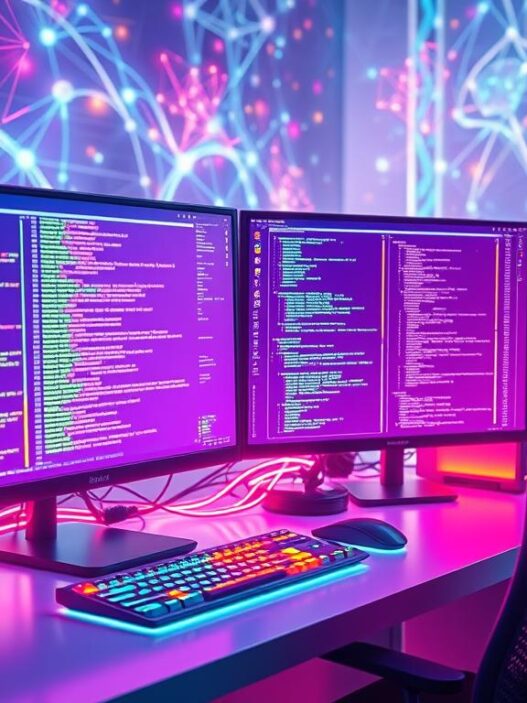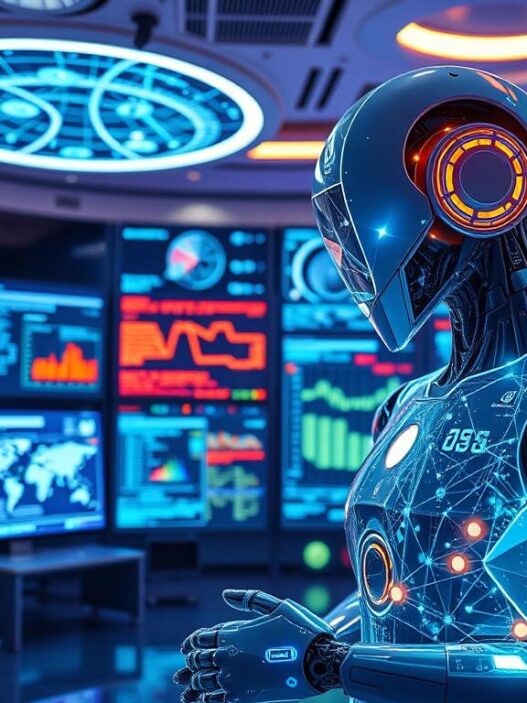The cutting edge of AI image creation introduces DALL·E 2, by OpenAI. This tech leads in creative AI, blending innovation with careful practices. It changes how we think about AI safety, filtering content, and avoiding bias. DALL·E 2 is special not just for making images but also for how seriously it takes the authenticity of these images. This shows OpenAI’s dedication to developing AI the right way.
OpenAI worked hard to get DALL·E 2 ready for the complex ethical world it faces. They filtered out harmful images from the vast internet visuals1. Moreover, they took on the complex job of avoiding bias by changing how the AI learns1. They also made sure to remove any duplicate images to keep the data pure1. OpenAI proved its commitment to keeping AI-created content trustworthy.
Key Takeaways
- OpenAI’s DALL·E 2 sets a benchmark in AI image generation, balancing creativity with ethical considerations.
- Pre-training measures involved the meticulous filtering of content to prevent the generation of unsuitable images1.
- Bias within the AI model has been addressed through targeted adjustments to the data set1.
- Maintaining image authenticity remains a cornerstone of DALL·E 2’s development, limiting the risk of data regurgitation through duplicate removal1.
- Ensuring the safe deployment of DALL·E 2, OpenAI continues its pursuit of enhancing pre-training mitigations1.
Understanding DALL·E 2 and Its Vision for AI Art
The arrival of DALL·E 2 is a major event in AI art. It changes how we see creativity and AI’s role in art. This tool by OpenAI shows the latest in AI skills. It’s based on deep learning and lots of neural network training.
By looking at tons of data, DALL·E 2 uses AI development to turn text into amazing, unique images23.
The Origins of DALL·E 2 and Its Place in AI Development
DALL·E 2 is an advanced version of the original and uses advanced models. It makes images by really understanding the text2. This step forward lets DALL·E 2 create clear images from words. It pushes the limits of what AI can do with pictures2.
OpenAI used about 650 million image-text pairs to train it. This solid base helps it create but also starts discussions on ethics and copyright3.
How DALL·E 2 Is Redefining Creative AI Image Generation
DALL·E 2 is not just about making images. Its real power is in changing AI creativity. It offers tools like image editing and style understanding. These help a lot in AI art.
These tools let people express their ideas and feelings digitally23.
OpenAI also sees DALL·E 2’s role in society. They’re making it available to more people. This makes digital creation more inclusive3. But, they’re being careful to avoid problems like misuse or deepfakes. This shows the ethical challenges AI faces23.
Want to know more about how this AI changes things? Go deeper into DALL·E 2’s development and effects at TechTarget.
Breaking Down DALL·E 2 Pre-Training Mitigations
AI is getting more advanced, making it crucial to use safety measures before training. DALL·E 2, developed by OpenAI, includes several strategies to prevent misuse. These help the model to create content in a responsible way.
The Need for Pre-Training Mitigations and Model Behaviour
DALL·E 2 uses a special design that processes many tasks at once. This improves how well it can turn text into pictures4. It’s advanced, supports many uses, yet focuses on safety and good AI habits from the start.
Filtering Explicit Content: A Pre-Emptive Approach
To avoid creating inappropriate content, OpenAI filters out bad images from the internet5. This keeps the AI from learning harmful material. It shows a commitment to create content wisely and maintain responsible AI use.
Addressing Bias and Representation Before Training Begins
OpenAI works hard to make AI more fair by adjusting how it learns5. They change algorithms to fix biases and strive for diversity. This makes sure all kinds of people are represented correctly.
Ensuring Data Privacy and Reducing Memorization Risks
DALL·E 2’s way of handling data is designed to keep information private. It doesn’t memorize exact images, which helps follow copyright rules5. By grouping similar images, it lowers the risk of breaking privacy laws.
| Feature | Description | Impact |
|---|---|---|
| Filtering explicit content | Removal of harmful imagery before training | Prevents AI from learning and generating unsafe content |
| Bias mitigation | Re-weighting data to balance demographic representation | Ensures fairness and diversity in content generation |
| Memorization risk reduction | Cluster-based image comparison | Protects privacy and adheres to copyright norms |

Examining the Filter Mechanisms Within DALL·E 2
DALL·E 2 keeps getting better, especially at making sure it creates content responsibly. It’s working hard to avoid making anything that’s inappropriate. This effort shows OpenAI’s dedication to making AI that’s ethical, setting a good example for others working on AI.
When dealing with filtering sexual and violent content, OpenAI has made big strides in keeping such content out of DALL·E 2’s creations. This move is key to making sure the content it makes is responsible. It’s about making the internet a safer place, as the recent study here6 talks about.
How Filtering Sexual and Violent Content Impacts Output
OpenAI uses smart filtering and looks for any bias in its data to keep DALL·E 2’s creations clean and fair. This is crucial for not creating or spreading harmful content. They’ve even made sure their AI’s training data doesn’t have this kind of content to begin with, lowering the chances of it showing up in their work.
Addressing Stereotypes and Demographic Biases
OpenAI also works hard to make sure DALL·E 2 doesn’t reinforce stereotypes or unfair biases. They do this by carefully checking and adjusting the data it learns from. This has helped make gender representation better and cut down biases, leading to more diverse and fair content.
Complexity of Handling Duplicate Image Data
Dealing with repeat images in DALL·E 2 shows the tricky work of keeping creativity high while making sure the data is unique. OpenAI uses smart methods like grouping similar images to make filtering easier. These steps help manage the huge amount of data and assure that new creations are truly original and varied.
In wrapping up, the updates to DALL·E 2, with its strong filters and focus on ethical AI, mark a big step forward in AI that’s made responsibly. OpenAI keeps aiming high, trying to make AI that’s not only advanced but also respectful and fair.
| Feature | Impact |
|---|---|
| Efficient Data Filtering | Reduces risk of explicit content generation |
| Bias Detection | Improves demographic inclusivity in AI outputs |
| Duplicate Image Detection | Ensures uniqueness and creativity in generated images |
Navigating the Risks: What Future AI Deployments Can Learn from DALL·E 2
The fast-changing world of artificial intelligence teaches us a lot through DALL·E 2 by OpenAI. This tech shows us the creative side of AI but also points out tough challenges. We must keep content true and make sure we have good plans to stop misuse.
Emerging Challenges in AI Ethics and Safety
OpenAI’s work with DALL·E 2 sheds light on important issues in AI’s future. Keeping user data private is crucial when making generative models. They use differential privacy, which means mixing data to hide personal details while keeping the data useful7. Also, removing sensitive info from data is key, balancing privacy with usefulness7. These actions build trust in AI systems, leading to more ethical AI use.
Analysing the Impact on Authenticity of Content
The effect of DALL·E 2 goes beyond new tech, sparking big talks about content truth. AI-made images can mix up real with fake, making people doubt digital media. To fight this, OpenAI works hard to keep content real. Keeping digital content trustworthy is vital today.

If you want to know more about these ethical and safety issues, check out in-depth AI talks in various fields here. These can give you more ideas on how to use AI responsibly.
| AI Ethics Issue | Mitigation Strategy | Impact on Trust |
|---|---|---|
| Data Privacy | Sanitization and Differential Privacy | Increases |
| Content Authenticity | Strict Pre-training Mitigations | Enhances |
| AI Misuse | Continuous Model Evaluation | Strengthens |
This table clearly shows how AI ethics issues link to solutions and how they help trust. It stresses the need for strong action plans, taken from DALL·E 2’s lessons. Making sure AI in the future is both new and trusted is essential.
Maximizing the Safety and Creativity of AI Image Generators
The transformative power of AI in art is huge, with DALL·E 3 leading the way. It combines creativity with advanced technology. This creates beautiful visuals but also requires a focus on ethical AI. We must use AI responsibly to keep the space safe and innovative.
Engaging Ethical Considerations in Artificial Intelligence
With DALL·E 3’s development, OpenAI introduced a strong ethical framework. This ensures AI technologies are used responsibly. The model has higher safety measures and content filters to avoid misuse, like creating inappropriate images or deep fakes. This shows OpenAI’s dedication to ethical AI8.
Additionally, as AI model rules get stricter, OpenAI leads by not making images in the style of living artists and public figures. This maintains moral and artistic integrity8.
Outlining OpenAI’s Strategies for Safer AI Deployment
From the start, OpenAI aimed to make AI like DALL·E 3 risk-proof by using multimodal learning. This approach helps understand data better8. Part of their strategy includes detecting and denying ethically bad requests. This ensures DALL·E remains a tool for good8.
Also, combining ChatGPT with DALL·E 3 for better image prompts is smart. It allows more user control over the creative process. This reduces errors before creating images8.
Looking forward, combining safety, creativity, and ethics in AI image generators is key. Following DALL·E 2’s ethics and OpenAI’s strategies can make AI a huge help. It can become a transformative tool for us all.
Conclusion
Reflecting on AI advancements, OpenAI’s DALL·E 2 marks a significant step forward. It’s trained on 650 million images and captions9. This training shows AI’s power to make detailed, creative visuals from text. This can be seen in work shared through personal experiments.
The model uses a complex method to produce art10. But, alongside these achievements, we see critical ethical considerations in its use. A 23-member team found biases in DALL·E 29. OpenAI worked hard to reduce these issues before launch. This underlines the importance of watchful use and discussion of such AI tools.
The future of AI looks promising yet challenging. It draws on lessons from DALL·E 2’s reception9. There’s excitement for its new applications and concerns over built-in cultural biases. AI creators must be careful to respect ethical limits. OpenAI aims to progress safely, hoping AI will aid us wisely. This hope is shared in the broader AI conversation.




















